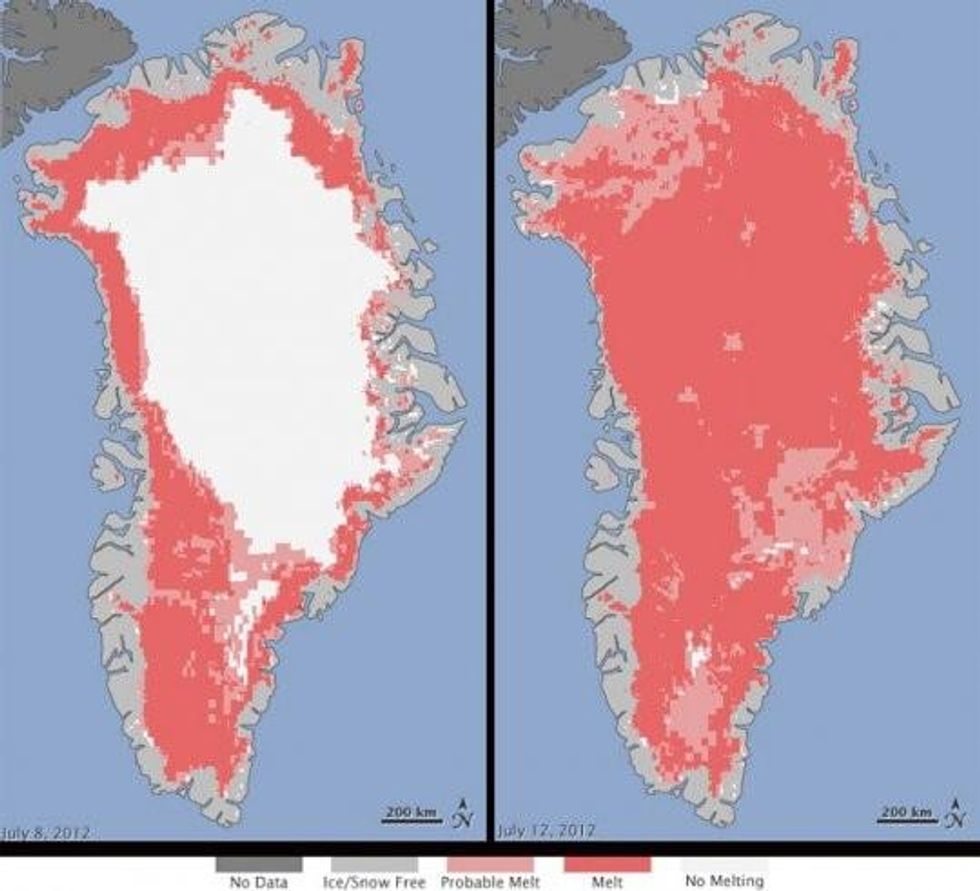'Not a Mistake': NASA in Disbelief over Area of Melting Ice
Greenland ice sheet melted an unprecedented area during July

Scientists say there has been a freak event in Greenland this month: Nearly every part of the massive ice sheet that blankets the island suddenly started melting.
The ice melted so fast that scientists at NASA first thought it was a computer error or some other malfunction.
For several days this month, Greenland's surface ice cover melted over a larger area than at any time in more than 30 years of satellite observations, according to a statement released along with satellite images on Tuesday.
"This was so extraordinary that at first I questioned the result: was this real or was it due to a data error?" Son Nghiem of NASA's jet propulsion laboratory in Pasadena said in the release.
But after conferring with colleagues, Nghiem's disbelief turned to shock.
"I think it's fair to say that this is unprecedented," Jay Zwally, a glaciologist at NASA's Goddard Space Flight Center, told The Guardian.
On average in the summer, about half of the surface of Greenland's ice sheet naturally melts. At high elevations, most of that melt water quickly refreezes in place. Near the coast, some of the melt water is retained by the ice sheet and the rest is lost to the ocean. But this year the extent of ice melting at or near the surface jumped dramatically. According to satellite data, an estimated 97 percent of the ice sheet surface thawed at some point in mid-July.
Researchers have not yet determined whether this extensive melt event will affect the overall volume of ice loss this summer and contribute to sea level rise.
"The Greenland ice sheet is a vast area with a varied history of change. This event, combined with other natural but uncommon phenomena, such as the large calving event last week on Petermann Glacier, are part of a complex story," said Tom Wagner, NASA's cryosphere program manager in Washington. "Satellite observations are helping us understand how events like these may relate to one another as well as to the broader climate system."
Even the area around Summit Station in central Greenland, which at 2 miles above sea level is near the highest point of the ice sheet, showed signs of melting. Such pronounced melting at Summit and across the ice sheet has not occurred since 1889, according to ice cores analyzed by Kaitlin Keegan at Dartmouth College in Hanover, N.H. A National Oceanic and Atmospheric Administration weather station at Summit confirmed air temperatures hovered above or within a degree of freezing for several hours July 11-12.
"Ice cores from Summit show that melting events of this type occur about once every 150 years on average. With the last one happening in 1889, this event is right on time," says Lora Koenig, a Goddard glaciologist and a member of the research team analyzing the satellite data. "But if we continue to observe melting events like this in upcoming years, it will be worrisome."
# # #
An Urgent Message From Our Co-Founder
Dear Common Dreams reader, The U.S. is on a fast track to authoritarianism like nothing I've ever seen. Meanwhile, corporate news outlets are utterly capitulating to Trump, twisting their coverage to avoid drawing his ire while lining up to stuff cash in his pockets. That's why I believe that Common Dreams is doing the best and most consequential reporting that we've ever done. Our small but mighty team is a progressive reporting powerhouse, covering the news every day that the corporate media never will. Our mission has always been simple: To inform. To inspire. And to ignite change for the common good. Now here's the key piece that I want all our readers to understand: None of this would be possible without your financial support. That's not just some fundraising cliche. It's the absolute and literal truth. We don't accept corporate advertising and never will. We don't have a paywall because we don't think people should be blocked from critical news based on their ability to pay. Everything we do is funded by the donations of readers like you. Will you donate now to help power the nonprofit, independent reporting of Common Dreams? Thank you for being a vital member of our community. Together, we can keep independent journalism alive when it’s needed most. - Craig Brown, Co-founder |

Scientists say there has been a freak event in Greenland this month: Nearly every part of the massive ice sheet that blankets the island suddenly started melting.
The ice melted so fast that scientists at NASA first thought it was a computer error or some other malfunction.
For several days this month, Greenland's surface ice cover melted over a larger area than at any time in more than 30 years of satellite observations, according to a statement released along with satellite images on Tuesday.
"This was so extraordinary that at first I questioned the result: was this real or was it due to a data error?" Son Nghiem of NASA's jet propulsion laboratory in Pasadena said in the release.
But after conferring with colleagues, Nghiem's disbelief turned to shock.
"I think it's fair to say that this is unprecedented," Jay Zwally, a glaciologist at NASA's Goddard Space Flight Center, told The Guardian.
On average in the summer, about half of the surface of Greenland's ice sheet naturally melts. At high elevations, most of that melt water quickly refreezes in place. Near the coast, some of the melt water is retained by the ice sheet and the rest is lost to the ocean. But this year the extent of ice melting at or near the surface jumped dramatically. According to satellite data, an estimated 97 percent of the ice sheet surface thawed at some point in mid-July.
Researchers have not yet determined whether this extensive melt event will affect the overall volume of ice loss this summer and contribute to sea level rise.
"The Greenland ice sheet is a vast area with a varied history of change. This event, combined with other natural but uncommon phenomena, such as the large calving event last week on Petermann Glacier, are part of a complex story," said Tom Wagner, NASA's cryosphere program manager in Washington. "Satellite observations are helping us understand how events like these may relate to one another as well as to the broader climate system."
Even the area around Summit Station in central Greenland, which at 2 miles above sea level is near the highest point of the ice sheet, showed signs of melting. Such pronounced melting at Summit and across the ice sheet has not occurred since 1889, according to ice cores analyzed by Kaitlin Keegan at Dartmouth College in Hanover, N.H. A National Oceanic and Atmospheric Administration weather station at Summit confirmed air temperatures hovered above or within a degree of freezing for several hours July 11-12.
"Ice cores from Summit show that melting events of this type occur about once every 150 years on average. With the last one happening in 1889, this event is right on time," says Lora Koenig, a Goddard glaciologist and a member of the research team analyzing the satellite data. "But if we continue to observe melting events like this in upcoming years, it will be worrisome."
# # #

Scientists say there has been a freak event in Greenland this month: Nearly every part of the massive ice sheet that blankets the island suddenly started melting.
The ice melted so fast that scientists at NASA first thought it was a computer error or some other malfunction.
For several days this month, Greenland's surface ice cover melted over a larger area than at any time in more than 30 years of satellite observations, according to a statement released along with satellite images on Tuesday.
"This was so extraordinary that at first I questioned the result: was this real or was it due to a data error?" Son Nghiem of NASA's jet propulsion laboratory in Pasadena said in the release.
But after conferring with colleagues, Nghiem's disbelief turned to shock.
"I think it's fair to say that this is unprecedented," Jay Zwally, a glaciologist at NASA's Goddard Space Flight Center, told The Guardian.
On average in the summer, about half of the surface of Greenland's ice sheet naturally melts. At high elevations, most of that melt water quickly refreezes in place. Near the coast, some of the melt water is retained by the ice sheet and the rest is lost to the ocean. But this year the extent of ice melting at or near the surface jumped dramatically. According to satellite data, an estimated 97 percent of the ice sheet surface thawed at some point in mid-July.
Researchers have not yet determined whether this extensive melt event will affect the overall volume of ice loss this summer and contribute to sea level rise.
"The Greenland ice sheet is a vast area with a varied history of change. This event, combined with other natural but uncommon phenomena, such as the large calving event last week on Petermann Glacier, are part of a complex story," said Tom Wagner, NASA's cryosphere program manager in Washington. "Satellite observations are helping us understand how events like these may relate to one another as well as to the broader climate system."
Even the area around Summit Station in central Greenland, which at 2 miles above sea level is near the highest point of the ice sheet, showed signs of melting. Such pronounced melting at Summit and across the ice sheet has not occurred since 1889, according to ice cores analyzed by Kaitlin Keegan at Dartmouth College in Hanover, N.H. A National Oceanic and Atmospheric Administration weather station at Summit confirmed air temperatures hovered above or within a degree of freezing for several hours July 11-12.
"Ice cores from Summit show that melting events of this type occur about once every 150 years on average. With the last one happening in 1889, this event is right on time," says Lora Koenig, a Goddard glaciologist and a member of the research team analyzing the satellite data. "But if we continue to observe melting events like this in upcoming years, it will be worrisome."
# # #

